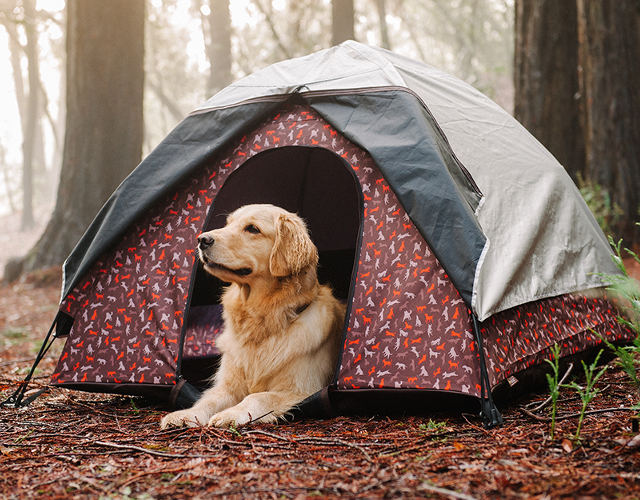We hope everyone had a very safe and fun 4th of July!
Here are some great tips on camping with your pet!
Camping is a common way for people and their dogs to get away from the stressors of life and relax in the great outdoors. It also helps strengthen the bond between person and dog. There are, however, important considerations to be made. After all, removing a dog from the safe confines of your house or yard creates a variety of potential dangers that otherwise would likely not be faced if the pet were to remain home.
Pending the location, time of year, climate, degree of insect infestation, proximity to wildlife, general health of your pet and other factors, camping can either be a great activity or a significant health and safety challenge for all parties involved.
Are You Safely Transporting Your Pet?
Most owners transport pets in their own cars, trucks, or even Winnebago-style campers. When taking a dog from your home to the campsite, common sense practices should always be taken to ensure safe travels. The first step: choosing the right travel harness.
Some dogs wear harnesses for day-to-day walks, but that same harness may not be suitable to attach to a seat belt and securely restrain him to the seat. According to the Center for Pet Safety (CPS) many harnesses don?t fit the bill to keep your pet secure in case of a crash. “Pet travel harnesses come in two forms, those that only prevent distraction and those that provide actual crash protection? select a quality crash-tested harness to protect your pet and also protect your family if an accident occurs.”
My top recommendation is to use a sturdy crate with rigid plastic walls. Firmly attaching the crate to your car?s interior keeps a pet better restrained and reduces the likelihood that the pet-in-crate combination will be tossed around the car during a sudden stop or accident. The CPS suggests putting “the small carrier on the floor of the vehicle behind the front passenger or driver seat.”
Additionally, make sure your pet wears a collar or chest harness adorned with an identifying tag and/or embroidered with the pet?s name and your phone number. This will increase the chances your dog is returned should he or she get lost on the way to or at the campsite. Dogs which are microchipped have an even greater rate of return should they go missing and enter the shelter system. So have your veterinarian implant a microchip before your planned departure, and make sure your pet?s ID number is registered with your current contact information.
Is Your Chosen Camping Site Safe For Your Pet?
Wherever you choose to set up camp, keep your pet’s safety at the forefront of the planning process.
Many parts of the country harbor insects that live to feed from your dog?s blood and potentially spreading life-threatening bacterial, parasitic, or viral infections. Tickscommonly spread bacterial pathogens like Lyme Disease, Ehrhlichia, Rocky Mountain Spotted Fever, and others. Mosquitoes may carry parasites like heartworm (Dirofilaria immitis).
It’s essential to properly and thoroughly protect your pets from these arthropod-disease carriers (vectors) to ensure that their long-term health will persist. Consult with your veterinarian to establish the most appropriate parasite-prevention strategy for your pets. A single medication or multiple products having the ability to deter fleas, ticks, and mosquitos may be needed to protect your pet.
Additionally, your pet may become prey for another animal, depending on the density of wildlife populations at your chosen camping spot. Humans tend to attract wildlife to homes and camp sites through their habits of bringing food to areas commonly not having such delicacies. Keep food supply and trash in secure containers inside your vehicle to deter the scavenging attempts of wildlife.
Coyote, hawks, bears, wolves, and others could track, snatch, and kill your dog. Raccoons, possum, and other smaller animals could fight with your pet, create significant bite-wound trauma, and spread potentially fatal disease (Rabies, oral cavity bacteria, etc.). Always walk your dog on a short, flat lead (not an extendable lead) when going out for bathroom breaks and never leave a dog tied up at your campsite unobserved.
When Was Your Dog’s Last Vet Checkup?
If you plan to take your pet camping, schedule a physical examination with your veterinarian within a few weeks before your departure date. This way, he or she can determine if your dog is healthy enough to travel and camp. An anti-parasite protocol and other strategies can also be discussed to ensure your dog has the safest camping experience possible.
We have a special on Frontline
when you buy 3 doses you get one dose free!
Please give us a call at 509-924-4558
if you have any questions or concerns
At Heart Arrow We Love Pets!
~*~*~*~*~*~*~*~*~*
Thanks to PETMD for portions of this article

